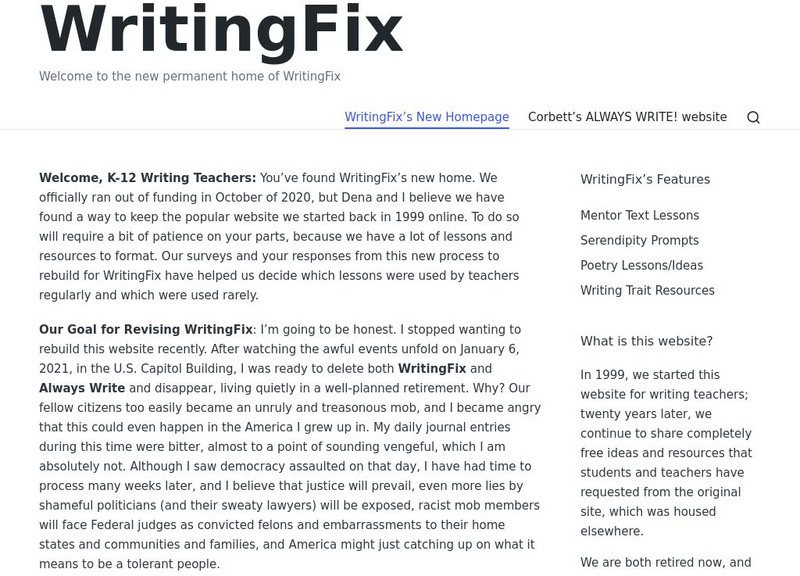Hi, what do you want to do?
Curated OER
The Study of the Spanish-Speaking People of Texas
Students analyze photographs from an historical perspective. They examine photos on the Study of Spanish-Speaking People of Texas website, complete a worksheet, and write an essay.
Curated OER
Be a Good Friend
Students discover characteristics of a good friend. In this social skills lesson, students read Clifford's Manners and discuss ways Clifford used his manners in the story. An activity that rewards students for modeling being courteous...
Curated OER
Japanese Poetry: Tanka? You're Welcome!
Young scholars analyze Japanese tanka poetry. In this Japanese poetry lesson, students identify analyze the structure of tanka poetry. Young scholars complete the activities at the given links for the lesson and compose two tanka poems.
Curated OER
Rap as Lyrical Poetry
Young scholars investigate the history of rap as an analysis of lyrical poetry and hip hop culture. In this rap analysis lesson, students watch a PBS NewsHour clip about the difference between rap music and hip hop culture. Young...
Curated OER
And The Oscar Goes To?
Third graders complete a graphic organizer to determine what a good story looks and sounds like. Using various forms and conventions, they determine which style to use for different audiences and purposes. They write their own story and...
Curated OER
Impact on Your Essence
Students are introduced to the use of symbolism and how it can change one's view of a piece of art. Using a piece of art, they view it as if they were the artist and create a symbol that accompanies it. They discuss the impact of two-...
Curated OER
Images of China
Students examine the Chinese poem "The River-Merchant's Wife: A Letter" by Li Po while comparing the different ways of "reading" an artwork in order to understand the differences between Chinese and American painting.
Curated OER
Good E-mail Manners
Students discuss online e-mail safety and etiquette rules and how they should apply the same rules in cyberspace as they use when encountering strangers in the face-to-face world. They participate in mock situations and tell what the...
Curated OER
Puberty
Eighth graders describe the changes their body undergoes during puberty. In this health science lesson, 8th graders explain how the hypothalamus and pituitary gland play a major role in the process. They identify the different parts of...
Curated OER
Watch Out for the Wasp!
Students increase their reading fluency through the use of various strategies. After reviewing chunking and rereading, students complete an initial read of a novel text. Working with a partner, they read complete a timed assessment of...
Curated OER
Recreating a Masterpiece
Students analyze and critique various artists and their work. They write research papers on artists and create reproductions of their works, reflecting their earlier critiques of the works.
Curated OER
Joining Together to Fight Gun Violence
Learners engage in meaningful dialogues on the issue of gun violence and to explore avenues that could lead to changes in our society.
Curated OER
Pipe-Cleaner Stick Figures
Second graders create puppets out of pipe cleaners and, in groups, put on a puppet show based on a section of a story they have read from their readers.
Curated OER
Strange Encounters
Third graders examine a variety of Robert Harris' paintings. Using the characters in the art, they develop a conversation between them in a musical verse. In groups, they identify safety procedures to be used by those traveling in the...
Curated OER
Non-Violence against Women Day
Students examine International Non-Violence Against Women Day in relation to the Mirabal Sisters from the Dominican Republic. They watch a movie, answer discussion questions, and write an essay.
Curated OER
Mental Circus
Students listen to different types of music and observe their classmates reaction to the music. They state why they think some reactions happened or did not happen.
Curated OER
Character Study in Macbeth
Eleventh graders analyze a Shakespeare soliloquy by writing a prose summary of it. They keep a character journal, following one character through the play and analyzing what the character does and says, as well as, might have done or...
Curated OER
Social Studies: War and the Media
Students examine the impact of the media on various wars, especially the Iraq and Vietnam wars. By examining cartoons and popular music as primary sources, they suggest motivations for the conflicts and propose reasons for public...
PBS
Pbs Learning Media: Arthur: Feelings
Young children experience a wide range of emotions that they might not be able to name yet. Help students explore emotions.
Committee for Children
Second Step: Grade 1: Lesson 13: Strong Feelings
In this Second Step lesson, 1st graders will learn how to recognize their feelings so that they can calm themselves.
Committee for Children
Lesson 12: Identifying Our Own Feelings
In this Second Step instructional activity, 1st graders will learn how to recognize their feelings by identifying physical cues.
Committee for Children
Second Step: Grade 1: Lesson 12: Identifying Our Own Feelings
In this Second Step lesson, 1st graders will learn how to identify feelings by paying attention to physical cues in their bodies.
ReadWriteThink
Read Write Think: Lesson Plans: Using Personal Connections to Understand Emotions
A lesson plan in which younger students draw on prior experiences that made them happy or sad, build two-sided masks, work with Venn diagrams, and connect personally with the emotions conveyed by poems in The Way I Feel by Janan Cain...
Writing Fix
Writing Fix: Showing How to Deal With Anger
Molly Bang's book, When Sophie Get's Angry-Really, Really Angry, provides students with positive ways of dealing with anger. When students explore their own methods of dealing with anger and then talk and write about new ways of...

























